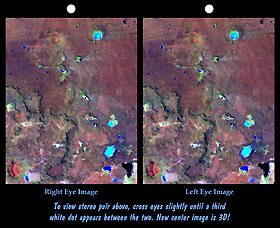
Save this image free of charge
in 800 pixels for layout use
(right click, Save as...)
|
|
Ref : V01901
Theme :
Looking at Earth - Plains - Plateaus - Valleys (487 images)
Title : Stereo Pair: Inverted Topography, Patagonia, Argentina
Caption :
The Meseta de Somuncura is a broad plateau capped by basalt. Near its western edge is evidence of multiple volcanic events and a complex erosion history. Most notable are the long, narrow-, and winding lava flows that run across most of the right side of the image. These formed from low-viscosity lava that flowed down gullies over fairly flat terrain. Later, erosion of the landscape continued and the solidified flows were more resistant than the older surrounding rocks. Consequently, the flows became the ridges we see here. This natural process of converting gullies to ridges is called topographic inversion. Other features seen here include numerous and varied closed depressions. The regional drainage is not well integrated, and drainage ends up in salty lakes (blue if shallow, black if deep). Wind streaks indicate that winds blow toward the east (right) and blow salt grains off the lakebeds when dry. The bowtie pattern in the upper left has resulted from differing grazing practices among fenced fields.This cross-eyed stereoscopic image pair was generated using topographic data from the Shuttle Radar Topography Mission, combined with an enhanced Landsat 7 satellite color image. The topography data are used to create two differing perspectives of a single image, one perspective for each eye. In doing so, each point in the image is shifted slightly, depending on its elevation. When stereoscopically merged, the result is a vertically exaggerated view of the Earth's surface in its full three dimensions.Landsat satellites have provided visible light and infrared images of the Earth continuously since 1972. SRTM topographic data match the 30-meter (99-foot) spatial resolution of most Landsat images and provide a valuable complement for studying the historic and growing Landsat data archive. Elevation data used in this image was acquired by the Shuttle Radar Topography Mission (SRTM) aboard the Space Shuttle Endeavour, launched on February 11, 2000. SRTM used the same radar instrument that comprised the Spaceborne Imaging Radar-C/X-Band Synthetic Aperture Radar (SIR-C/X-SAR) that flew twice on the Space Shuttle Endeavour in 1994. SRTM was designed to collect three-dimensional measurements of the Earth's surface. To collect the 3-D data, engineers added a 60-meter-long (200-foot) mast, installed additional C-band and X-band antennas, and improved tracking and navigation devices. The mission is a cooperative project between the National Aeronautics and Space Administration (NASA), the National Imagery and Mapping Agency (NIMA) of the U.S. Department of Defense (DoD), and the German and Italian space agencies. It is managed by NASA's Jet Propulsion Laboratory, Pasadena, CA, for NASA's Earth Science Enterprise, Washington, DC.Size: 21.5 kilometers (13.4 miles) x 27.2 kilometers (16.9 miles) Location: 41.6 deg. South lat., 67.9 deg. West lon.Orientation: North toward upper left Image Data: Landsat bands 1,4,7 in blue, green, red Date Acquired: February 19, 2000 (SRTM), January 22, 2000 (Landsat)
|
|

